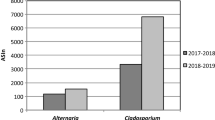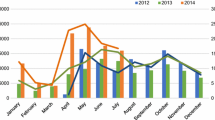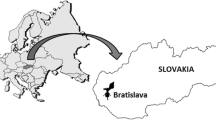Abstract
Cladosporium spp. and Alternaria spp. spores are dominating the airspora of Denmark. Currently, little is known about the influence of climate change on the fungal spore abundance in the air. The aim of this study was to examine temporal changes in airborne Alternaria and Cladosporium spores over 26 years. This is the first report of long-term airborne Cladosporium spore occurrence in Denmark. Air spore concentrations were obtained with a Burkard volumetric spore sampler placed in Copenhagen, Denmark, during June–September, 1990–2015. The highest monthly Spore integrals (SIn) for Alternaria were measured in August, whereas for Cladosporium July SIn was nearly as high as August SIn. Average Alternaria seasonal spore integral (SSIn) was 8615 Spores day m−3, while average 3-month (July–September) Cladosporium SIn was 375,533 Spores day m−3. Despite increasing annual temperature and decreasing relative humidity, we found a decreasing trend for Alternaria seasonal SIn (Slope = − 277, R2 = 0.38, p < 0.05), Alternaria (Slope = − 31, R2 = 0.27, p < 0.05) and Cladosporium (Slope = − 440, R2 = 0.23, p < 0.05) annual peak concentrations. We did not find any statistically significant trends for airborne Alternaria seasonal characteristics and duration, and likewise for Cladosporium 3-month SIn and peak concentration dates. Mean temperature was the main meteorological factor affecting daily spore concentrations. However, effect of meteorological parameters on daily spore concentrations was stronger for Cladosporium (R2 = 0.41) than for Alternaria (R2 = 0.21). Both genera had diurnal peaks during the day hours, earlier for Cladosporium (11:30–14:30) and later for Alternaria (15:00–19:00). Although Alternaria and Cladosporium daily concentrations were moderately correlated (Spearman’s correlation coefficient: rs = 0.55, p < 0.05), their overall annual indices were different, which indicates different sources and different factors determining spore release. We explain temporal decreasing trends in Alternaria SSIn by growing urbanisation around Copenhagen and by changes in agricultural practices.





Similar content being viewed by others
References
Aira, M.-J., Rodríguez-Rajo, F.-J., Fernández-González, M., Seijo, C., Elvira-Rendueles, B., Gutiérrez-Bustillo, M., et al. (2012). Cladosporium airborne spore incidence in the environmental quality of the Iberian Peninsula. Grana,51(4), 293–304.
Aira, M.-J., Rodríguez-Rajo, F.-J., Fernández-González, M., Seijo, C., Elvira-Rendueles, B., Abreu, I., et al. (2013). Spatial and temporal distribution of Alternaria spores in the Iberian Peninsula atmosphere, and meteorological relationships: 1993–2009. International Journal of Biometeorology,57(2), 265–274.
Almeida, E., Caeiro, E., Todo-Bom, A., Ferro, R., Dionísio, A., Duarte, A., et al. (2018). The influence of meteorological parameters on Alternaria and Cladosporium fungal spore concentrations in Beja (Southern Portugal): Preliminary results. Aerobiologia,34(2), 219–226.
Atkinson, R. W., Strachan, D. P., Anderson, H. R., Hajat, S., & Emberlin, J. (2006). Temporal associations between daily counts of fungal spores and asthma exacerbations. Occupational and Environmental Medicine,63(9), 580–590.
Awad, A. H. A. (2005). Vegetation: A source of air fungal bio-contaminant. Aerobiologia,21(1), 53–61.
Bagni, N., Davies, R., Mallea, M., Nolard, N., Spireksma, F., & Stix, E. (1977). Spore concentration in cities of the European Economic Community. II. Spores of Cladosporium and Alternaria. Acta Allergologica, 32(2), 118–138.
Bardei, F., Bouziane, H., Trigo, M. D. M., Ajouray, N., El Haskouri, F., & Kadiri, M. (2017). Atmospheric concentrations and intradiurnal pattern of Alternaria and Cladosporium conidia in Tétouan (NW of Morocco). Aerobiologia,33(2), 221–228.
Bednarz, A., & Pawlowska, S. (2016). A fungal spore calendar for the atmosphere of Szczecin, Poland. Acta Agrobotanica,69(3), 1–9.
Boddy, L., Büntgen, U., Egli, S., Gange, A. C., Heegaard, E., Kirk, P. M., et al. (2014). Climate variation effects on fungal fruiting. Fungal Ecology,10, 20–33.
Bruffaerts, N., De Smedt, T., Delcloo, A., Simons, K., Hoebeke, L., Verstraeten, C., et al. (2018). Comparative long-term trend analysis of daily weather conditions with daily pollen concentrations in Brussels, Belgium. International Journal of Biometeorology,62(3), 483–491.
Busck, A. G., Kristensen, S. P., Præstholm, S., Reenberg, A., & Primdahl, J. (2006). Land system changes in the context of urbanisation: Examples from the peri-urban area of Greater Copenhagen. Geografisk Tidsskrift-Danish Journal of Geography,106(2), 21–34.
Cappelen, J., Kern-Hansen, C., Laursen, E. V., Jørgensen, P. V., Jørgensen, P. V., & Jørgensen, B. V. (2017). DMI report 17-02. In C. John (Ed.), Denmark—DMI Historical Climate Data Collection 1768–2016. Copenhagen, Denmark: Danish Meteorological Institute.
Cecchi, L., D’Amato, G., Ayres, J., Galan, C., Forastiere, F., Forsberg, B., et al. (2010). Projections of the effects of climate change on allergic asthma: The contribution of aerobiology. Allergy,65(9), 1073–1081.
Chrenová, J., Mišík, M., Ščevková, J., Mičieta, K., & Mlynarčík, D. (2004). Monitoring of microscopic airborne fungi in Bratislava. Acta Facultatis Pharmaceuticae Universitatis Comenianae,51, 68–72.
Corden, J. M., & Millington, W. M. (2001). The long-term trends and seasonal variation of the aeroallergen Alternaria in Derby, UK. Aerobiologia,17(2), 127–136.
Corden, J. M., Millington, W. M., & Mullins, J. (2003). Long-term trends and regional variation in the aeroallergen Alternaria in Cardiff and Derby UK—Are differences in climate and cereal production having an effect? Aerobiologia,19(3/4), 191–199.
Crameri, R., Garbani, M., Rhyner, C., & Huitema, C. (2014). Fungi: The neglected allergenic sources. Allergy,69(2), 176–185.
D’Amato, G., Holgate, S. T., Pawankar, R., Ledford, D. K., Cecchi, L., Al-Ahmad, M., et al. (2015). Meteorological conditions, climate change, new emerging factors, and asthma and related allergic disorders. A statement of the World Allergy Organization. World Allergy Organization Journal,8(1), 1.
D’Amato, M., Cecchi, L., Annesi-Maesani, I., & D’Amato, G. (2018). News on climate change, air pollution, and allergic triggers of asthma. Journal of Investigational Allergology and Clinical Immunology,28(2), 91–97.
Damialis, A., Mohammad, A. B., Halley, J. M., & Gange, A. C. (2015a). Fungi in a changing world: Growth rates will be elevated, but spore production may decrease in future climates. International Journal of Biometeorology,59(9), 1157–1167.
Damialis, A., Vokou, D., Gioulekas, D., & Halley, J. M. (2015b). Long-term trends in airborne fungal-spore concentrations: A comparison with pollen. Fungal Ecology,13, 150–156.
Ellermann, T., Nygaard, J., Nøjgaard, J. K., Nordstrøm, C., Brandt, J., Christensen, J., et al. (2016). The Danish Air Quality Monitoring Programme. Annual Summary for 2015. Scientific Report from DCE—Danish Centre for Environment and Energy No. 201 (pp. 65). Aarhus University, DCE—Danish Centre for Environment and Energy.
Fernández-Rodríguez, S., Sadyś, M., Smith, M., Tormo-Molina, R., Skjøth, C. A., Maya-Manzano, J. M., et al. (2015). Potential sources of airborne Alternaria spp. spores in South-west Spain. Science of The Total Environment,533, 165–176.
Fertner, C. (2012). Urbanisation, urban growth and planning in the Copenhagen Metropolitan Region with reference studies from Europe and the USA. Forest & Landscape, University of Copenhagen. Forest and landscape research, No. 54/2012.
Fleming, Z. L., Monks, P. S., & Manning, A. J. (2012). Review: Untangling the influence of air-mass history in interpreting observed atmospheric composition. Atmospheric Research, 104–105, 1–39.
Friesen, T. L., De Wolf, E. D., & Francl, L. J. (2001). Source strength of wheat pathogens during combine harvest. Aerobiologia,17(4), 293–299.
Galan, C., Ariatti, A., Bonini, M., Clot, B., Crouzy, B., Dahl, A., et al. (2017). Recommended terminology for aerobiological studies. Aerbiologia,33, 293–295.
García-Mozo, H., Yaezel, L., Oteros, J., & Galán, C. (2014). Statistical approach to the analysis of olive long-term pollen season trends in southern Spain. Science of The Total Environment,473, 103–109.
Giner, M. M., García, J. C., & Camacho, C. N. (2001). Airborne Alternaria spores in SE Spain (1993–98). Occurrence patterns, relationship with weather variables and prediction models. Grana,40(3), 111–118.
Gravesen, S. (1979). Fungi as a cause of allergic disease. Allergy,34(3), 135–154.
Grinn-Gofroń, A., & Mika, A. (2008). Selected airborne allergenic fungal spores and meteorological factors in Szczecin, Poland, 2004–2006. Aerobiologia,24(2), 89.
Grinn-Gofroń, A., Nowosad, J., Bosiacka, B., Camacho, I., Pashley, C., Belmonte, J., et al. (2019). Airborne Alternaria and Cladosporium fungal spores in Europe: Forecasting possibilities and relationships with meteorological parameters. Science of The Total Environment,653, 938–946.
Heinzerling, L. M., Burbach, G. J., Edenharter, G., Bachert, C., Bindslev-Jensen, C., Bonini, S., et al. (2009). GA2LEN skin test study I: GA2LEN harmonization of skin prick testing: novel sensitization patterns for inhalant allergens in Europe. Allergy,64(10), 1498–1506.
Hirst, J. M. (1952). An automatic volumetric spore trap. Annals of Applied Biology,39(2), 257–265.
Hollins, P., Kettlewell, P., Atkinson, M., Stephenson, D., Corden, J., Millington, W., et al. (2004). Relationships between airborne fungal spore concentration of Cladosporium and the summer climate at two sites in Britain. International Journal of Biometeorology,48(3), 137–141.
Kasprzyk, I. (2008). Aeromycology—Main research fields of interest during the last 25 years. Annals of Agricultural and Environmental Medicine,15(1), 1–7.
Kasprzyk, I., & Worek, M. (2006). Airborne fungal spores in urban and rural environments in Poland. Aerobiologia,22, 169–176.
Kasprzyk, I., Sulborska, A., Nowak, M., Szymanska, A., Kaczmarek, J., Haratym, W., et al. (2013). Fluctuation range of the concentration of airborne Alternaria condiospores sampled at different geographical locations in Poland (2010–2011). Acta Agrobotanica,66(1), 65–76.
Kasprzyk, I., Kaszewski, B. M., Weryszko-Chmielewska, E., Nowak, M., Sulborska, A., Kaczmarek, J., et al. (2016). Warm and dry weather accelerates and elongates Cladosporium spore seasons in Poland. Aerobiologia,32(1), 109–126.
Katotomichelakis, M., Nikolaidis, C., Makris, M., Proimos, E., Aggelides, X., Constantinidis, T. C., et al. (2016). Alternaria and Cladosporium calendar of Western Thrace: Relationship with allergic rhinitis symptoms. The Laryngoscope,126(2), E51–E56.
Larsen, L., & Gravesen, S. (1991). Seasonal variation of outdoor airborne viable microfungi in Copenhagen, Denmark. Grana,30(2), 467–471.
Levetin, E., Horner, W. E., Scott, J. A., Barnes, C., Baxi, S., Chew, G. L., et al. (2016). Taxonomy of Allergenic Fungi. The Journal of Allergy and Clinical Immunology: In Practice, 4(3), 375–385.e371.
Mitakakis, T. Z., Clift, A., & McGee, P. A. (2001). The effect of local cropping activities and weather on the airborne concentration of allergenic Alternaria spores in rural Australia. Grana,40(4–5), 230–239.
Nilsson, S., & Persson, S. (1981). Tree pollen spectra in the Stockholm region (Sweden), 1973–1980. Grana,20(3), 179–182.
O'Connor, D. J., Sadyś, M., Skjøth, C., Healy, D. A., Kennedy, R., & Sodeau, J. R. (2014). Atmospheric concentrations of Alternaria, Cladosporium, Ganoderma and Didymella spores monitored in Cork (Ireland) and Worcester (England) during the summer of 2010. Aerobiologia,30(4), 397–411.
Olesen, M., Madsen, K. C., Ludwigsen, C. A., Boberg, F., Christensen, T., Cappelen, J., et al. (2014). Fremtidige klimaforandringer i Danmark. Damarks Klimacenter rapport nr. 6 Copenhagen: Danmarks Meteorologiske Institut.
Oliveira, M., Ribeiro, H., Delgado, J. L., & Abreu, I. (2009). Seasonal and intradiurnal variation of allergenic fungal spores in urban and rural areas of the North of Portugal. Aerobiologia,25(2), 85–98.
Olsen, Y., Begovic, T., Skjøth, C. A., Rasmussen, K., Gosewinkel, U., Hertel, O., et al. (2019a). Grain harvesting as a local source of Cladosporium spp. in Denmark. Aerobiologia,35(2), 373–378.
Olsen, Y., Gosewinkel, U., Skjøth, C. A., Hertel, O., Rasmissen, K., & Sigsgaard, T. (2019b). Regional variation in airborne Alternaria spore concentrations in Denmark through 2012–2015 seasons: the influence of meteorology and grain harvesting. Aerobiologia,35(3), 533–551.
Peternel, R., Culig, J., & Hrga, I. (2003). Atmospheric concentrations of Cladosporium spp. and Alternaria spp. spores in Zagreb (Croatia) and effects of some meteorological factors. Annals of agricultural and environmental medicine AAEM,11(2), 303–307.
Rasmussen, A. (2002). The effects of climate change on the birch pollen season in Denmark. Aerobiologia,18(3), 253–265.
Reyes, E. S., de la Cruz, D. R., Merino, E., & Sánchez, J. S. (2009). Meteorological and agricultural effects on airborne Alternaria and Cladosporium spores and clinical aspects in Valladolid [Spain]. Annals of Agricultural and Environmental Medicine,16(1), 53–61.
Rizzi-Longo, L., Pizzulin-Sauli, M., & Ganis, P. (2009). Seasonal occurrence of Alternaria [1993-2004] and Epicoccum [1994–2004] spores in Trieste [NE Italy]. Annals of Agricultural and Environmental Medicine,16(1), 63–70.
Rodríguez-Rajo, F. J., Iglesias, I., & Jato, V. (2005). Variation assessment of airborne Alternaria and Cladosporium spores at different bioclimatical conditions. Mycological Research,109(4), 497–507.
Sadyś, M. (2017). Effects of wind speed and direction on monthly fluctuations of Cladosporium conidia concentration in the air. Aerobiologia,33(3), 445–456. https://doi.org/10.1007/s10453-017-9482-6.
Sadyś, M., Skjøth, C. A., & Kennedy, R. (2015). Determination of Alternaria spp. habitats using 7-day volumetric spore trap, Hybrid Single Particle Lagrangian Integrated Trajectory model and geographic information system. Urban Climate,14, 429–440.
Ščevková, J., & Kováč, J. (2019). First fungal spore calendar for the atmosphere of Bratislava, Slovakia. Aerobiologia,35(2), 343–356.
Ščevková, J., Dušička, J., Mičieta, K., & Somorčík, J. (2016). The effects of recent changes in air temperature on trends in airborne Alternaria, Epicoccum and Stemphylium spore seasons in Bratislava (Slovakia). Aerobiologia,32(1), 69–81.
Şen, B., & Asan, A. (2001). Airborne fungi in vegetable growing areas of Edirne, Turkey. Aerobiologia,17(1), 69–75.
Simeray, J., Chaumont, J.-P., & Léger, D. (1993). Seasonal variations in the airborne fungal spore population of the East of France (Franche-Comte). Comparison between urban and rural environment during two years. Aerobiologia,9(2–3), 201–206.
Sindt, C., Besancenot, J.-P., & Thibaudon, M. (2016). Airborne Cladosporium fungal spores and climate change in France. Aerobiologia,32(1), 53–68.
Skjøth, C. A., Sommer, J., Brandt, J., Hvidberg, M., Geels, C., Hansen, K. M., et al. (2007). Copenhagen—a significant source of birch (Betula) pollen? International Journal of Biometeorology,52(6), 453.
Skjøth, C. A., Sommer, J., Frederiksen, L., & Gosewinkel Karlson, U. (2012). Crop harvest in Denmark and Central Europe contributes to the local load of airborne Alternaria spore concentrations in Copenhagen. Atmospheric Chemistry and Physics,12(22), 11107–11123.
Skjøth, C. A., Damialis, A., Belmonte, J., De Linares, C., Fernández-Rodríguez, S., Grinn-Gofroń, A., et al. (2016). Alternaria spores in the air across Europe: Abundance, seasonality and relationships with climate, meteorology and local environment. Aerobiologia,32(1), 3–22.
Smith, M., Jäger, S., Berger, U., Sikoparija, B., Hallsdottir, M., Sauliene, I., et al. (2014). Geographic and temporal variations in pollen exposure across Europe. Allergy,69, 913–923.
Sousa, L., Camacho, I. C., Grinn-Gofroń, A., & Camacho, R. (2016). Monitoring of anamorphic fungal spores in Madeira region (Portugal), 2003–2008. Aerobiologia,32(2), 303–315.
Stępalska, D., & Wołek, J. (2009). Intradiurnal periodicity of fungal spore concentrations (Alternaria, Botrytis, Cladosporium, Didymella, Ganoderma) in Cracow, Poland. Aerobiologia,25(4), 333.
Stieb, D. M., Beveridge, R. C., Brook, J. R., Smith-Doiron, M., Burnett, R. T., Dales, R. E., et al. (2000). Air pollution, aeroallergens and cardiorespiratory emergency department visits in Saint John, Canada. Journal of Exposure Science and Environmental Epidemiology,10(5), 461–477.
Twaroch, T. E., Curin, M., Valenta, R., & Swoboda, I. (2015). Mold allergens in respiratory allergy: from structure to therapy. Allergy Asthma Immunol Res,7(3), 205–220.
Ugolotti, M., Pasquarella, C., Vitali, P., Smith, M., & Albertini, R. (2015). Characteristics and trends of selected pollen seasons recorded in Parma (Northern Italy) from 1994 to 2011. Aerobiologia,31(3), 341–352.
Walther, G.-R. (2010). Community and ecosystem responses to recent climate change. Philosophical Transactions of the Royal Society B: Biological Sciences.,365, 2019–2024.
Weryszko-Chmielewska, E., Kasprzyk, I., Nowak, M., Sulborska, A., Kaczmarek, J., Szymanska, A., et al. (2018). Health hazards related to conidia of Cladosporium—Biological air pollutants in Poland, central Europe. Journal of Environmental Sciences,65, 271–281.
Zasada, I., Fertner, C., Piorr, A., & Nielsen, T. S. (2011). Peri-urbanisation and multifunctional adaptation of agriculture around Copenhagen AU—Zasada, Ingo. Geografisk Tidsskrift-Danish Journal of Geography,111(1), 59–72.
Acknowledgements
We thank K. Mortensen, R. Keller and C. Nordstrøm for providing the meteorological data from the HCØ station.
Author information
Authors and Affiliations
Corresponding author
Electronic supplementary material
Below is the link to the electronic supplementary material.
Rights and permissions
About this article
Cite this article
Olsen, Y., Skjøth, C.A., Hertel, O. et al. Airborne Cladosporium and Alternaria spore concentrations through 26 years in Copenhagen, Denmark. Aerobiologia 36, 141–157 (2020). https://doi.org/10.1007/s10453-019-09618-7
Received:
Accepted:
Published:
Issue Date:
DOI: https://doi.org/10.1007/s10453-019-09618-7




